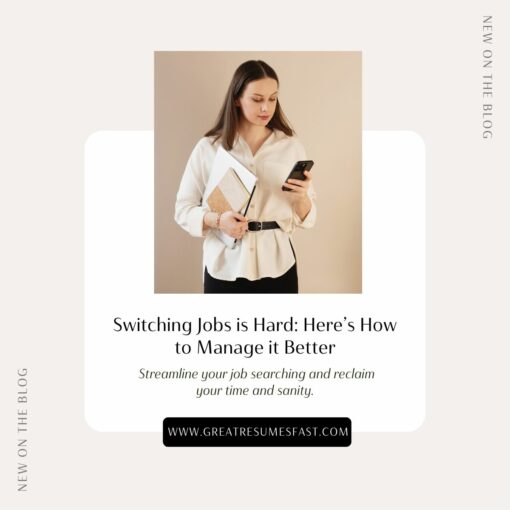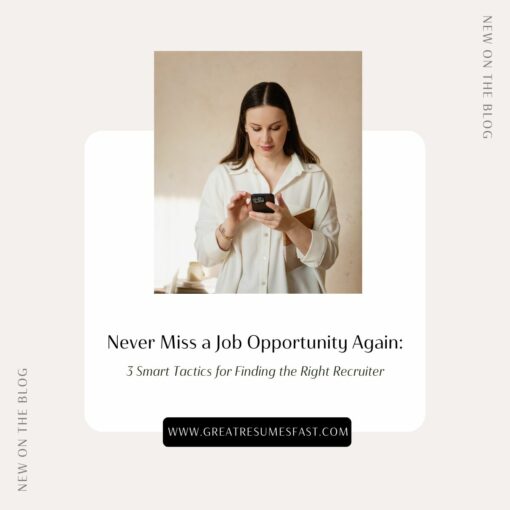How to Find a Job Using LinkedIn
Did you know that you’re nearly 3x more likely to get a job where you have connections on LinkedIn? You’re also 4 times more likely to be hired through your network. LinkedIn has become an invaluable tool for job seekers, and if you’re wondering how to find a job using LinkedIn this article contains all the steps you need to take.

In today’s article I’ll discuss:
– How to make your profile discoverable
– How to increase your visibility
– The important role of keywords and skills
– Tools you can use to research and why you need to research
– Simple daily actions that only take 5-10 minutes but deliver large gains in your search
Before I dive into the strategies themselves, I want to share a few key points:
There are currently 1.9 million talented professionals actively using LinkedIn to find candidates. This means there’s a real possibility that your next employer could find you on LinkedIn.
Connections take time to foster, and to be sustainable they need to be win/win. In other words, asking for a job isn’t your first move.
Begin building up your network. You need connections on LinkedIn because you have to have some type of connection with someone to see their profile unless they are a premium member and have “Open connector” turned on.
The best way to get started is to start now. Take action by importing your contacts and connecting with family, friends, classmates, and coworkers. This will give you baseline connections that will open up the doorway to many new connections.
When building your network, send a personalized note stating why you want to connect. When you connect with someone, all their 1st-degree connections become your 2nd-degree connections—which means now you can search/find more people. This is how you can connect with thought leaders, people in your industry, and people at companies that you want to work for.
How to Increase Your Visibility so Recruiters Discover You
In order for recruiters to find you, your profile has to be discoverable. In order for your profile to be discoverable to recruiters, it needs skills and must have a strong summary that includes the right keywords.
The skills section of your profile allows you to include up to 50 skills that you can be endorsed for by your connections. The endorsements show recruiters where your strengths lie, but the skills themselves help bolster your appearance in search results and also indicate your fit for a role when you apply to a position that’s posted on LinkedIn.
For instance, if you apply to a role that requires Excel and you have Excel listed as a skill on your profile, it will show the hiring manager when they review your application that you are a match for that skill. It will also show you 10 skills required for the role and how many of those 10 you possess. This is a great way to assess if you have the right skills listed on your profile that are relevant to the role you’re targeting. If you don’t have the right skills listed, you won’t be categorized as a “fit” for the job.
If you notice that the positions you’re applying to require many of the same skills and you possess those skills but they’re not listed on your profile, be sure you add them as soon as possible. If you don’t possess a required skill you could opt to learn it by taking a LinkedIn Learning course that would then show completed on your profile. This shows the employer that you’ve taken the course and possess the knowledge. It also allows you to include the skills within your profile.
This single change to my husband’s profile when he was job searching shot up his profile views 8500%. One of the students in my LinkedIn Unlocked course made this change and saw a 700% increase, another student had a 1200% increase. It works!
Recruiter searches
Recruiters can use the LinkedIn Recruiter dashboard to search for candidates that possess certain skills, keywords, certifications, degrees, and many other search options. They can also filter by “most likely to respond” or “open to new opportunities.”
Open to finding a new job
If you’re actively searching, using this LinkedIn feature can be of great benefit. When you turn the feature on you can select job title, locations, whether you’re open to remote work, start date, job types, and also who sees you’re open to finding a new job. The options are recruiters only or everyone on LinkedIn. Selecting any member of LinkedIn adds the green “Open to Work” banner on your profile image, and also lets visitors know you’re open to new opportunities at the top of your profile page.
Another note when it comes to recruiter contact is that you may want to consider LinkedIn Premium because you get the ability to direct message recruiters. You also receive more detailed applicant insights including if you’re a top applicant. As of this writing, you can try LinkedIn Premium and get a 30-Day free trial with my affiliate link here. LinkedIn has a “career plan” that gives you access to these insights as well as interview preparation, salary insights, and LinkedIn Learning courses so you can earn or add skills in certain areas to your profile. That’s really handy if you’re missing some of the required skills for a role that you really want.
I want to point out that in a recent Careerbuilder survey, 70% of recruiters said they use social media to screen candidates. In another survey, 47% of companies stated they’re less likely to interview candidates if they can’t be found online. This shows companies do search for candidates to find out more about them.
LinkedIn allows you to have a positive online presence and to manage that presence. With LinkedIn, you can proactively control what employers see about you and give them great information.
The Importance of Keywords
An important filter that recruiters use to search candidates on LinkedIn is keywords. Keywords are important to your profile so that recruiters can find you, but also so that others in your industry or those searching to make connections with people in your industry can find you.
But which keywords do you use?
I recommend choosing those that align with the role and industry that you’re targeting. You can search job postings on LinkedIn, profiles of those in your industry, and content in your industry in LinkedIn articles or status updates to gather a list of keywords.
You can also use a word cloud like TagCloud. Simply copy and paste the job descriptions. Click visualize and get a word cloud. This will give you the most commonly used words. These are the most likely keywords that you need to add to your profile.
Another option for identifying keywords is to use LinkedIn’s Resume Builder tool to scan your profile for keywords and get suggestions of keywords that are not in your profile but need to be. A side note here is that with Premium you can unlock 15 more keywords, so if you opt for the free one-month trial you could get up to 25 keyword recommendations from LinkedIn. I consider their keyword suggestions insider intelligence because their system is telling you exactly what keywords/skills you need to get the type of role that you’re targeting.
Once you have your list of keywords, you need to add them to your summary (About section), the skills section of your profile, your profile headline, and under the work experience section where you’re writing about each role.
Maximize Your Work Experience
One of the biggest mistakes I see people make on LinkedIn is that they include their previous places of employment; job title, date, and company, but they leave the description of what they accomplished blank.
This is a huge missed opportunity.
It’s important to add accomplishments because otherwise, recruiters won’t know what you contributed or how you added value.
Include bullets here. This is important for keywords but also so employers and your connections can see what you’ve done. It’s also beneficial for hiring managers to see if you’re a good fit for their opening and for your network to make recommendations to you about opportunities that come up.
One other benefit of using the work experience section is that you get to tell your story— especially critical when you’re making a transition because you can highlight transferable skills.
Optimize the Skills Section
The skills section of LinkedIn is probably the most overlooked and underutilized. Most job seekers overlook how important it really is to their job search. The skills listed on your profile help determine placement in search results, whether you’re categorized as a fit or not a fit for a role that you’ve applied to, and the jobs LinkedIn recommends to you.
Here’s my advice to optimize this section of your profile:
- You can add up to 50 skills. Use all of them! These skills show up in position postings when you apply to determine if you’re a fit. Also, when recruiters search, they can search by skills.
- Skills are categorized three ways as industry knowledge, tools and technology, and interpersonal skills.
- Obviously, don’t add anything that isn’t true.
- Your connections can endorse you for these skills.
- These skills make your profile discoverable to recruiters conducting talent searches.
- Be intentional. Add skills that will help you qualify for the jobs you’re looking for now. That’s why doing the research I mentioned in the previous step is so important.
- You can take skill assessments to show you have mastery of a certain skill. Recruiters can actually search by these assessments and pull candidates that have taken them. This is yet another way to be discoverable.
How to Use LinkedIn as a Research Tool to Find and Get the Job You Want
Another often-underutilized aspect of LinkedIn is its function as a research tool. One of the best ways to use LinkedIn is to research people on LinkedIn with a similar job title to the one you want. You can then follow them, connect, and ask for advice or an informational interview. And after you’ve built a great connection, see what other opportunities open up—like a referral.
I also recommend that you look up profiles of people who work at a company you want to work for, review what skills and keywords they use, and see what they’re posting.
You also want to research interviewers for common ground, shared experiences, or to find out what they value. It gives you a competitive edge.
Tip: this is why it’s important to build your connections/network on LinkedIn. Without any connections, you can’t see people’s profiles in your industry or in the positions that you want to target.
Research companies. Learn all about the company. But also click on people. You can get all types of insights about the people who work there, what they do, and who they’re connected to. Going into an interview being prepared and knowledgeable about the company and its employees is important. Following a company on LinkedIn increases your chances of working there.
By researching a company page on LinkedIn you can:
- View profiles of people who work at the company.
- Check and interact with the company’s posts, read their About section, and see statistics.
- Choose the “Life” tab to learn about culture at the company. This is great interview prep.
The Alumni tool is another great research opportunity. Did you know that alumni are much more likely to respond and help you? Here are some tips:
- Search for your specific school.
- Go to the school page and use the Alumni tool to search for job titles, industries, and the years attended—you can broaden this range to find people who graduated close to you or ahead of you. You can even look by where they live (so they’re near you or where you want to move), where they work, or at a specific company that you want to work for. When you connect, ask questions like “What path did you take to work for _____?”
- See profiles of “People you may know.” Instead of being empty, you’ll see connections.
Daily Job Search Activities That Only Take 5-10 Minutes
One of my favorite pieces of advice to offer to job seekers involves practical actions you can take daily that don’t take much time. We all have 5 or 10 minutes a day that we can devote to something that is important to us.
Only have five minutes? Here are five job search activities you can do:
– Like three LinkedIn posts.
– Check a recruiter’s Twitter feed and engage with their tweet.
– Send a thank-you message to a connection.
– Comment on a company’s LinkedIn post, a hiring manager’s post, or a group post.
– Send a connection request on LinkedIn.
Have more time? Here are some 10-minute activities you can do:
– Message a network contact. Tip: Ask a specific question like “I’m considering certification A or B. Which do you recommend?”
– Write a LinkedIn status update. Tip: Offer advice or tips related to your industry or target role.
– Research a target company.
– Introduce yourself to a 2nd-degree connection.
– Find employees from one of your target companies on LinkedIn and connect.
Consistency is the key. These small daily actions add up when you repeat them five days a week for four to six weeks.
There are a few more job search tips that are really important that I don’t want you to miss.
First, add your resume to your LinkedIn account—you’ll need it to apply to many of the jobs on LinkedIn.
Second, make use of LinkedIn filters when applying. You can select remote work, location, commute, salary, benefits, industry, and more. You can even choose jobs with less than 10 applicants or that were posted in the past 24 hours (or some other time frame).
Third, you have a much better chance of getting a job at a company that you follow. LinkedIn actually lets recruiters know if you follow or interact with their company’s posts. It looks good on you if you’re interacting on LinkedIn with the company.
Finally, turn on job alerts. LinkedIn will alert you with daily/weekly alerts via email, notifications on LinkedIn, or both. Any time a new job comes up that fits your parameters, LinkedIn will let you know.
Follow the strategies that I’ve outlined here, and you’ll find your next job using LinkedIn.
What if you could organically attract interviews for your dream job through LinkedIn?
Even if you’ve been job searching for months with no traction or don’t have time to apply for jobs.
My “insider” method reveals how to use LinkedIn to speed up your job search and land a job you love.
Share this post:

About the author
Jessica Hernandez, President, CEO & Founder of Great Resumes Fast
Hi, I’m Jessica. I started this company back in 2008 after more than a decade directing hiring practices at Fortune 500 companies.
What started as a side hustle (before that was even a word!) helping friends of friends with their resumes has now grown into a company that serves hundreds of happy clients a year. But the personal touch? I’ve kept that.
You might have seen me featured as a resume expert in publications like Forbes, Fast Company, and Fortune. And in 2020, I was honored to be named as a LinkedIn Top Voice of the year!
I’m so glad you’re here, and I can’t wait to help you find your next perfect-fit position!
1 Comments
Leave a Comment
Improve Your Resume: Download Your Free Executive Resume Template Today
Are you struggling to create an executive resume that will impress employers? Download this free executive resume template and receive a series of 10 emails with expert guidance on how to write resume content that resonates with employers so you get more interviews.
It's everything you need to stand out, make an impression, and accelerate your job search.









Thank you for sharing this information.